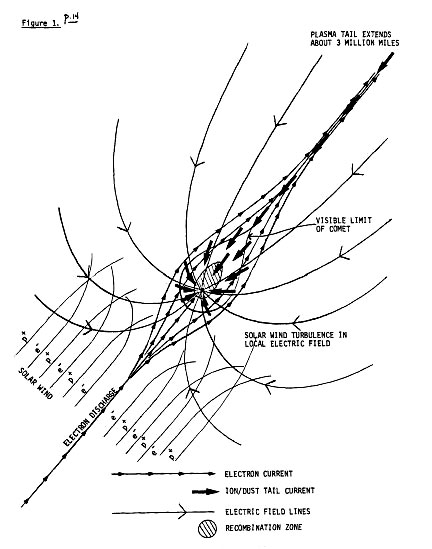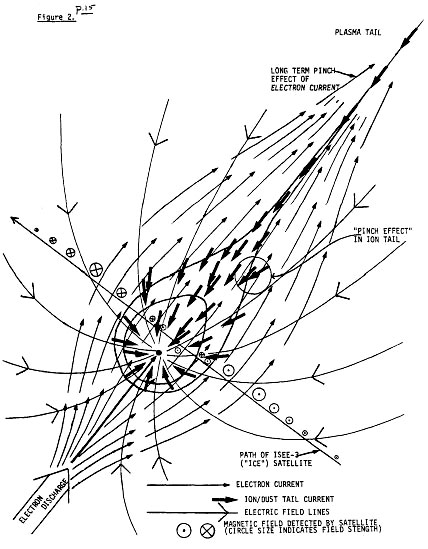|
from TheMilleniumGroup Website
Abstract
This excess current of positive charge leaves the sun with a net negative charge, forming a capacitor between the sun and rings which have been detected orbiting the sun, analogous to the rings of Saturn. The physics of the solar/saturnian systems and their capacitors are described in detail in the previously published series of papers.
From the initial look at detail recently obtained by the Goddard Space Flight Center's ISEE-3 satellite at comet Giacobini-Zinner, a more complete picture of the internal activity of the cometary discharge has been evaluated. This refined understanding of the small cometary discharge is the topic of the present paper.
The dynamics of larger more energetic comets are treated in other papers.
Primary results concerning the discharge of the solar capacitor included the following:
Once the physics of the solar capacitor and its discharge were understood, a limitation to further understanding and theoretical work was the lack of close range information on:
The details of this are best given as explanations of Figures 1 and 2.
Figure 1 shows the overall cometary discharge, and the interaction of the solar wind with the local electric field. Figure 2 details what the ISEE-3 satellite experienced during its transit of comet Giacobini-Zinner.
It is Figure 2 that should be examined closely In light of available data.
Figure 1 Caption. Overall view of a small cometary discharge. Note the turbulence of solar wind protons and electrons as they enter the comet's local electric field. (Arrows indicate direction of particle movement.)
Figure 1 illustrates the overall discharge of a small comet such as Giacobini-Zinner.
The visible limit of the dust tail Is labeled. The electric field extends about 160,000 km from the nucleus in the lateral direction (i.e., perpendicular to the discharge). The plasma tail and electron discharge (sunward side) extend out of the diagram.
A secondary effect is that this
separation of solar wind plasma creates a dielectric effect reducing
the extent of the comet's local electric field (i.e., it forms a
space charge sheath). This will fluctuate somewhat due to the
dynamic nature of the cometary discharge and solar wind plasma, but
can be viewed as a steady state system for simplicity in this paper.
The remaining current in the electron discharge fans around the comet nucleus as is apparent from the Giacobini-Zinner data.
Discussion of Figure 2
Figure 2 Caption. Close up of the dynamics of a small comet. Path of the ISEE-3 ("ICE") satellite is shown as it passed through comet Giacobini-Zinner on September 11, 1985. (Arrows indicate direction of particle movement.)
It is this diagram which will convince those with access to the comet probe data that comets are the observable effects of an energetic discharge of the solar capacitor.
A secondary effect of the solar wind
turbulence region is that a space charge sheath forms, limiting the
extent of the local electric and magnetic fields. Space craft
antennae begin to detect signatures of energetic electrons moving
upstream in the cometary discharge.
Note that electron energies provide useful information related to the potential differences in the solar capacitor.
If it were known, for example, that the
electron discharge extended from the solar corona (a good source of
free electrons), then electron energies measured at a given point in
the discharge would give the electrical potential of that point in
space relative to the sun.
Pinch instabilities occur as the induced magnetic field pulls a filament together, causing it to quickly collapse on itself. The pinch condition is unstable and "snaps" up the filament, as is commonly observed in any high current discharge (i.e., arcing around electrostatic generators). The probe then enters the visible comet tail area.
Figure 2 shows the pinch effect
occurring in tail ion currents flowing into the comet nucleus. The
pinch effect does not occur unless substantial currents are involved
(i.e., the dirty snowball model, with its diffuse low energy cloud
of ions dispersing in the solar wind plasma, cannot justify an
explanation based on the pinch effect).
So tail ions are detected arriving from
the sunward direction, just as Figure 2 illustrates ion movement on
the sunward side. Dust particles are affected less by the local
electric field of the satellite because their charge to mass ratios
are much lower.
The fact that water and CO+ ions were detected was anticipated from earth based observations. Ice ball comet theorists may claim this supports the dirty snowball model, however, this is but one similarity between that theory and observation. Since both theories predict this, it cannot be used to prove or disprove either theory.
The majority of observations, including
the richness of high energy phenomena, were not anticipated by the
ice ball comet model. This was specifically predicted in the
previous papers dealing with the solar capacitor discharge model.
Sometimes sulphur is prominent whereas heavy elements become
evident in comets that pass near the sun. One of the difficulties
with the ice ball model has been in explaining these patterns. The
solar capacitor discharge concept explains that the tail composition
depends on the source comet tail material, and therefore depends the
location of the comet within the ring structures which surround the
sun.
Figure 2 shows that the direction of magnetic field is now in the opposite direction as it was during the entry. It is not draped down the tail, however, it is into the page, perpendicular to direction of total current.
This work refers to previously published
papers which developed details on the dynamics of the capacitors
around the sun and Saturn.
|


